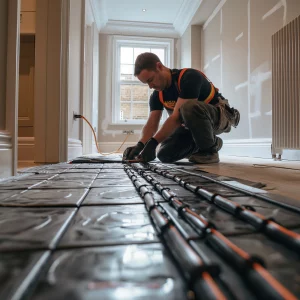
Introduction to Underfloor Heating Systems
In recent years, homeowners have increasingly sought more efficient, unobtrusive heating methods. Underfloor heating (UFH) systems offer a compelling solution. Once installed, they are invisible and supremely efficient at distributing heat. Such systems can be installed under various flooring types, including tile, stone, wood, and even carpet, making them versatile and effective.
Types of Underfloor Heating Systems

Electric Systems
Electric underfloor heating systems, also known as dry systems, employ either heating mats or loose heating cables to generate warmth. These mats or cables are typically spread out across the floor area and then covered with the flooring material of choice. This type of system is especially popular due to its simplicity in installation and its ability to be retrofitted in existing rooms without too much disruption.
Hydronic Systems
Hydronic underfloor heating, or wet systems, circulates heated water through a network of pipes laid under the floor. This method is generally more cost-effective for larger areas and is particularly common in new constructions or major renovations. Installing a hydronic system is more involved than an electric system, requiring careful consideration of the subfloor for optimal operation and efficiency.
“When considering underfloor heating, homeowners have two main choices: electric systems, ideal for smaller areas or retrofit projects due to their ease of installation, and hydronic systems, preferred for new constructions or larger spaces because of their efficiency over vast areas. Each type has its merits, and the choice often depends on the specific needs of the property and the homeowner’s long-term energy considerations.” – Charles Mitten, Mittens Underfloor Heating London.
Installation Process
The installation process varies significantly between electric and hydronic systems. For electric underfloor heating, the process generally involves laying out the heating mat or cables on a well-insulated surface to ensure heat is directed upwards into the room rather than being lost to the ground below. Measuring the room accurately and planning the layout to avoid cold spots and achieve uniform warmth throughout the space is crucial.
In contrast, installing a hydronic system involves a more complex sequence of tasks, including cleaning the subfloor, installing a layer of insulation, and carefully laying out the pipes in a pattern that ensures even heat distribution. This type of installation often requires professional handling to ensure the system functions efficiently and safely.
Cost and Efficiency
Initial Cost and Long-term Savings
While the initial installation cost of underfloor heating can be high, particularly for hydronic systems, long-term energy savings often offset this. UFH systems operate at lower temperatures than traditional heating methods but are more efficient in distributing heat uniformly across a room. This efficiency can reduce heating bills by up to 70%, depending on the existing heating setup and the home’s insulation quality.
Maintenance Costs
Maintenance requirements for underfloor heating systems are generally minimal since no moving parts like fans or blowers would typically wear out or need regular servicing. This reduces ongoing costs and makes UFH an appealing option for those looking for a low-maintenance home heating solution.
Energy Efficiency and Sustainability

Underfloor heating systems are compatible with renewable energy sources, such as solar panels, which can further reduce a home’s carbon footprint. By integrating UFH with a renewable energy system, homeowners can achieve nearly zero operational costs and significantly lessen their environmental impact.
Additionally, UFH systems’ lower operating temperatures make them an excellent match for high-efficiency boilers and heat pumps, enhancing the overall energy efficiency of the home. This synergy helps reduce energy consumption and supports broader sustainability goals by minimising reliance on non-renewable energy sources.
Comfort and Health Benefits
One of the standout advantages of underfloor heating systems is their enhanced comfort. Traditional heating systems often create uneven temperatures within a room—warm near the source and cooler further away. In contrast, underfloor heating distributes heat uniformly across the entire floor surface, rising evenly throughout the room and eliminating cold spots. This consistent heat distribution improves comfort and contributes to a healthier living environment by minimising the circulation of dust and allergens, which are more prevalent in systems that rely on forced air.
Enhanced Air Quality
Unlike radiators or forced air systems, which can circulate dust and other particulates throughout a space, underfloor heating reduces air movement within a room. This helps to significantly decrease the amount of airborne dust, making it a preferred choice for allergy sufferers. Additionally, the absence of radiators frees up wall space and minimises dust traps, simplifying cleaning and maintenance tasks.
Aesthetics and Space-Saving
Once installed, underfloor heating systems are invisible. They require no exposed hardware or ductwork, thus not interfering with a room’s aesthetic or furniture placement. This is particularly beneficial in modern homes, where minimalism and clean lines are favoured. By eliminating radiators, homeowners gain back valuable square footage and have complete freedom in interior design without planning around heating vents or radiators.
Integrating Design and Function
With no visible components, the design possibilities become endless. Flooring options remain flexible, as underfloor heating can be effectively installed beneath stone, tile, wood, and even carpet. The ability to maintain a consistent interior theme without the interruption of heating appliances allows for a seamless integration of style and function, enhancing the overall appeal and comfort of the home.
Control and Customization
Advanced Thermostatic Controls
Modern underfloor heating systems come equipped with sophisticated thermostatic controls that allow for precise temperature management. Homeowners can adjust settings for individual rooms or zones depending on the specific needs of each space. This level of control not only enhances comfort but also improves the home’s energy efficiency by reducing unnecessary heating.
Integration with Home Automation Systems
The latest advancements in home automation technology can be seamlessly integrated with underfloor heating systems. This allows for remote control of the heating system via smartphones or other devices, enabling homeowners to adjust settings on the go. For instance, one can lower the temperature when the house is empty and heat the home just before returning, ensuring optimal comfort while conserving energy.
Maintenance and Safety

Underfloor heating systems are designed to be low-maintenance, thanks to their few moving parts and the lack of regular cleaning or servicing that other heating systems require. Their durability often means that once installed, they can provide warmth for decades without significant intervention.
Safety Features
The safety benefits of underfloor heating are particularly notable. With the heating elements securely placed beneath the floor, hot surfaces are not exposed that could harm children or pets. This aspect makes UFH systems a safer alternative to traditional radiators or heaters that can pose burn risks.
Looking Forward: The Future of Home Heating
As we look towards the future, the role of underfloor heating in modern architecture and smart home design is set to expand. Integrating UFH systems with smart technology not only enhances user convenience but also optimizes energy use, adapting to households’ varying daily and seasonal heating needs.
Technological Innovations
Emerging technologies such as IoT (Internet of Things) enable more sophisticated control over heating systems, allowing them to learn from user behaviour and adjust settings automatically for maximum comfort and efficiency. Such innovations will likely make underfloor heating an even more attractive option for eco-conscious homeowners who prioritise sustainability and technological integration.
The Role of Policy and Regulation
Moreover, governmental policies and incentives to promote energy-efficient homes could further drive the adoption of underfloor heating. Regulations favouring the installation of energy-efficient appliances and systems could make UFH more accessible to a broader audience, accelerating its integration into mainstream construction practices.
In conclusion, underfloor heating systems represent a transformative development in residential heating. Offering unmatched comfort, improved air quality, and integration with renewable energy sources, these systems align with the modern homeowner’s goals of having a stylish, comfortable, and environmentally friendly home. As technological advancements continue to evolve, the potential for underfloor heating to redefine home comfort and efficiency is immense, making it a pivotal component of future home designs.